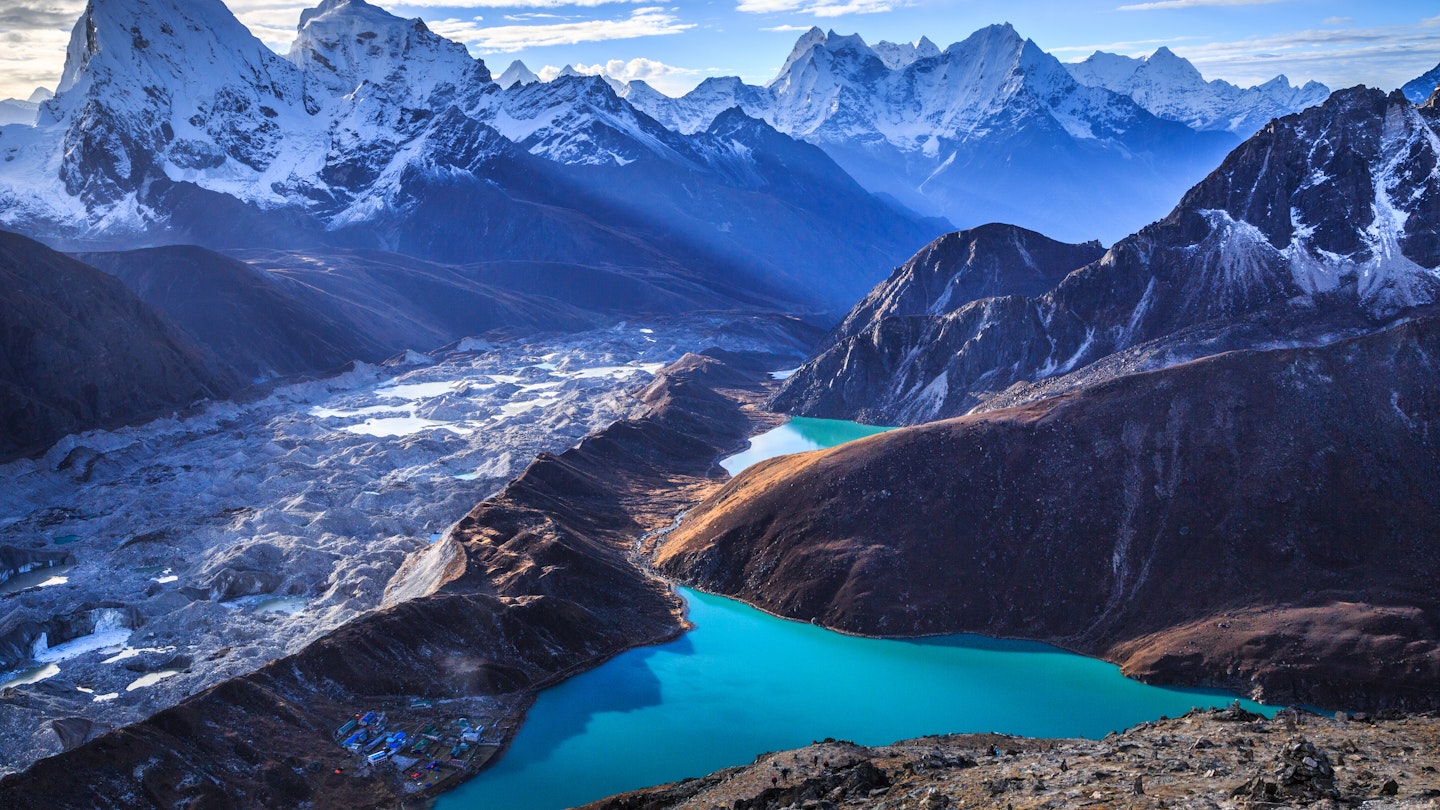For mountain lovers and the vertically inclined, the Himalayas represent nothing less than the crowning apex of nature’s grandeur. Here dramatic forested gorges rise to skylines of snow-capped glaciated peaks through a landscape that ranges from high-altitude desert to dripping rhododendron forest.
Home to some 50 million people, this is no alpine wilderness, but rather a vibrant mosaic of peoples, cultures, and communities, criss-crossed by ancient trading and pilgrimage routes that offer their own unique inspiration. Test your mettle against some of the world’s most audacious and dangerous roads, or set a more measured pace on a trek through yak pastures to prayer flag-strewn passes haunted by snow leopards and red pandas. Stretching in a 1550 mile-long arc (2500km) across Asia from Kashmir to Kathmandu, Lhasa to Ladakh, the Himalayan range is a big place. Focus your pilgrimage on one of these dream trips.
Ladakh – India’s little Tibet
Hidden over high passes in an arid, largely treeless rain shadow, Ladakh showcases classic Trans Himalayan scenery: huge khaki-colored valleys and harsh rock walls brought alive by the occasional splash of irrigated green. Traditional Tibetan Buddhist culture remains intact here, with spectacularly located monasteries that burst into life during medieval masked dance festivals that have changed little in 500 years. Travelers should expect epic treks, sparkling high-altitude mountain lakes, and well-developed infrastructure with inexpensive guesthouses around the capital, Leh.
When to go: June to September.
Getting there: Daily flights from Delhi to Leh, or take the spectacular seasonal high roads over the Himalayas from Manali or Srinagar.
Suggested itinerary: Hire a jeep or an Enfield motorbike and drive out to ancient Hemis, Lamayuru, and Thiksey monasteries, taking a side trip to the turquoise lake of Pangong Tso bordering Tibet; afterwards, embark on a five-day homestay trek through the Markha Valley.
Off the beaten track alternative: Spiti, in neighboring Himachal Pradesh, offers the same dramatic mountain scenery and monasteries but without the crowds. Trek from village to village with a local organization and overnight at the incredible monasteries of Dhankar and Tabo.
Tibet – Roof of the World
The high Tibetan plateau is the rooftop of Asia, hidden from the Indian subcontinent behind the ramparts of the Great Himalaya. Despite modernization led by China, Tibet’s great monasteries still hum with murmured mantras and the flicker of yak butter lamps. Sublime landscapes, ranging from rolling grasslands to high-altitude turquoise lakes, vibrant Buddhist culture, and the friendly and resilient Tibetan people are highlights here, as well as panoramic views of Everest’s North Face – miles better than anything you’ll see in Nepal.
When to go: Mid-May to September.
Getting there: Flights to Lhasa from Chengdu, Beijing, and many other cities in China, or take the world’s highest train from China to Lhasa.
Suggested itinerary: Join a tour for the seven- to ten-day overland trip from Lhasa to Kathmandu, stopping at the incredible multistory stupa at Gyantse and the spectacular medieval monastery at Sakya.
Off the beaten track alternative: Complete a rugged three-day trek around Asia’s most sacred peak, Mt. Kailash, in remote Western Tibet, and then explore Kashmiri-influenced art of Tsaparang and the Guge Kingdom, hidden deep in the eroded desert gorges of the Sutlej Valley. Paved roads and an airport outside Ali make this two-week trip much less arduous than it used to be, though hiring transport and a guide through an agency in Lhasa or Kathmandu is still necessary.
Nepal – A Trekker’s Paradise
The best way to experience the mountains is on foot, and Himalayan treks in Nepal offer spectacular and convenient options. Follow mountain paths past lines of spinning prayer wheels and charming stone Sherpa or Tamang villages to the foot of jaw-dropping 8000m peaks like Annapurna or Everest, while knowing that at the end of each day a cozy bed and hot dinner await you. Additionally, a visit to the medieval cities of the Kathmandu Valley, once a Himalayan artistic powerhouse, is a must.
When to go: March, April, October, November.
Getting there: Fly to Kathmandu and hop on a domestic flight to Lukla for the Everest region. Pokhara serves as the launch pad for treks in the Annapurna region.
Suggested itinerary: To trek to Everest Base Camp, you need a minimum of 14 days, but it is advisable to add a four-day side visit to the stunning mountain lakes of the Gokyo valley, factoring in ample time for acclimatization.
Off the beaten track alternative: The 17-day trek around Manaslu is possibly Nepal’s ultimate teahouse trek, allowing travelers to stay in lodges along the way or go camping expedition-style on an epic three-week journey to the Dolpo or Kanchenjunga regions.
Bhutan – The Last Shangri-La
As the last surviving great Himalayan kingdom, Bhutan exudes an otherworldly aura that seems rooted in another age. Traditional dress is commonplace, old-growth forest covers much of the countryside, and remote Himalayan peoples like the Layaps and Brokpas lead lives largely untouched by modernity. Bhutan truly feels like nowhere else on earth. The catch? A fixed minimum daily rate of US$250 per person is mandatory, which includes transport, meals, guides, and accommodation.
When to go: March, April, September, October.
Getting there: Fly to Paro from Delhi or Bangkok, or drive overland from neighboring India.
Suggested itinerary: Explore the enchanting Paro Valley and its iconic Tiger’s Nest Hermitage (Taktshang Goemba) before heading to the little-visited Haa Valley, the tiny capital of Thimphu, and the remarkable fortress-monastery of Punakha. Timing your visit around one of Bhutan’s colorful tsechus (monastic festivals) is highly recommended.
Off the beaten track alternative: The tiny Himalayan kingdom of Mustang in Nepal imposes a hefty daily permit cost (US$500 per person), but this offers a chance to explore centuries-old Tibetan architecture and possibly meet the king.
This article was first published on April 1, 2013, and updated on January 28, 2021.





